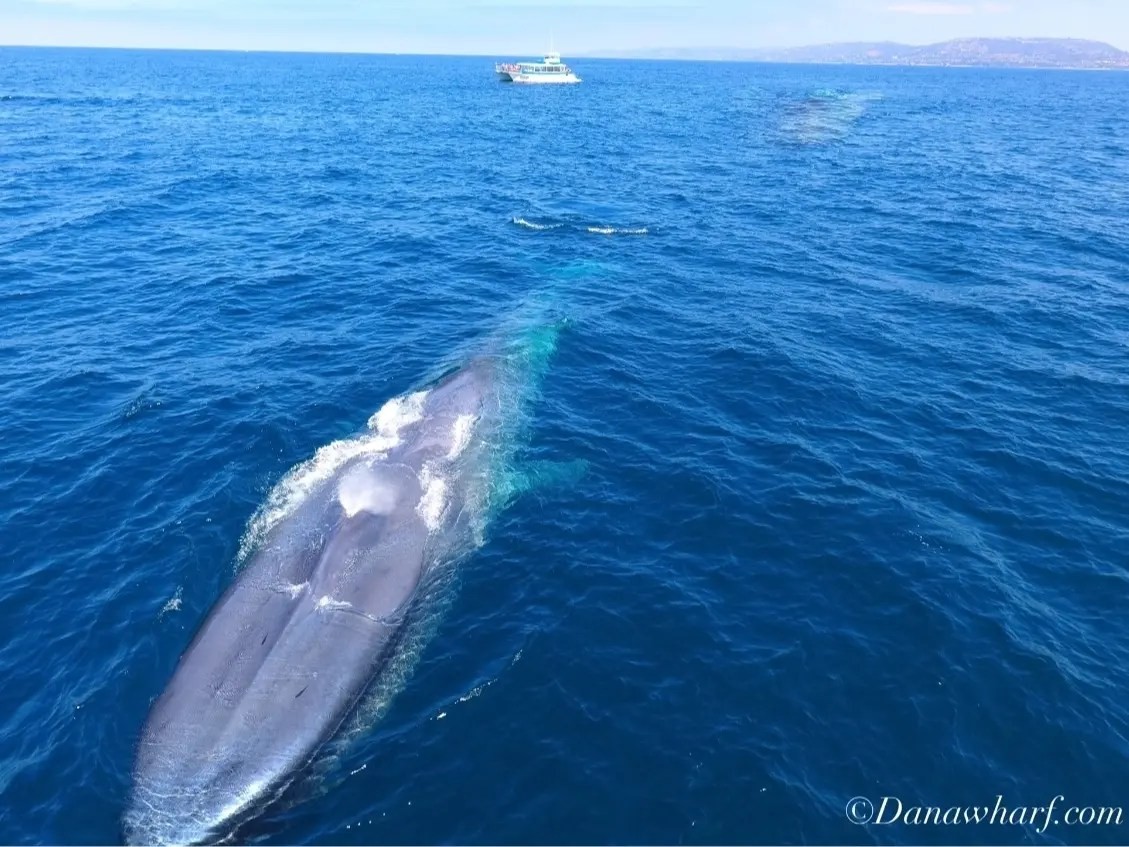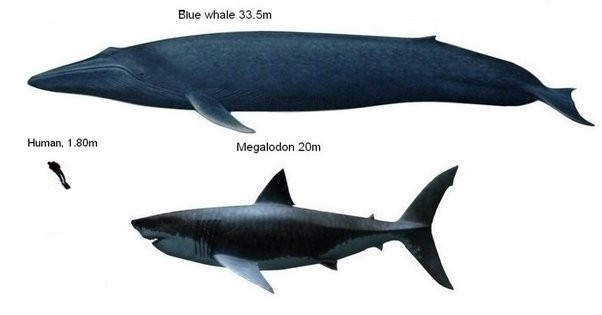Comparing the blue whale size to the megalodon reveals fascinating insights into the scale of these marine giants. At COMPARE.EDU.VN, explore comprehensive comparisons of marine life to inform your understanding. Discover their individual characteristics and differences.
1. Introduction: Giants of the Ocean
The ocean’s depths have always been home to creatures of immense size, capturing our imagination and curiosity. Two of the most impressive examples are the blue whale ( Balaenoptera musculus) and the megalodon (Otodus megalodon). The blue whale, the largest animal on Earth today, and the megalodon, an extinct mega-toothed shark, inspire awe and wonder. This article will explore their sizes, comparing them side-by-side, and examining the implications of their dimensions, offering a detailed size comparison between a blue whale versus megalodon.
2. Understanding the Blue Whale: The Gentle Giant
2.1. Size and Dimensions of the Blue Whale
The blue whale is not just large; it’s colossal. On average, a blue whale measures between 80 to 100 feet (24 to 30 meters) in length. However, some individuals have been recorded reaching lengths of up to 110 feet (33.5 meters). Their weight can range from 100 to 200 tons (90,000 to 180,000 kilograms). The heart of a blue whale is about the size of a small car, weighing around 1,300 pounds (600 kilograms). This enormous size is supported by an efficient body plan adapted for filter-feeding and long-distance migration.
2.2. Notable Features of the Blue Whale
Besides its sheer size, the blue whale has several other remarkable features:
- Diet: Blue whales primarily feed on krill, tiny crustaceans that they filter from the water.
- Habitat: They are found in all oceans, migrating between feeding and breeding grounds.
- Lifespan: Blue whales can live for 80 to 90 years.
- Conservation Status: Listed as endangered, blue whales face threats from ship strikes, entanglement in fishing gear, and climate change.
3. Discovering the Megalodon: The Prehistoric Predator
3.1. Size and Dimensions of the Megalodon
The megalodon was a formidable predator that lived between 23 and 3.6 million years ago. Estimating the exact size of megalodon has been a challenge, as sharks’ cartilaginous skeletons do not fossilize well. Scientists primarily rely on the size of their teeth, which can be up to 7 inches (18 centimeters) long, to estimate their overall length.
Based on these estimations, the megalodon is believed to have reached lengths of 50 to 67 feet (15 to 20.5 meters). Some studies suggest they could have grown even larger, but these estimates are less certain. Their weight is estimated to have been between 50 to 75 tons (45,000 to 68,000 kilograms).
3.2. Notable Features of the Megalodon
- Diet: Megalodon was an apex predator, likely feeding on large marine mammals, including whales, seals, and dolphins.
- Habitat: Fossil evidence suggests that megalodon inhabited warm and temperate oceans worldwide.
- Extinction: The reasons for their extinction are still debated but may include climate change, competition with other predators, and the decline of their prey.
4. Side-by-Side Comparison: Blue Whale vs. Megalodon
To truly appreciate the size difference, let’s compare the blue whale and megalodon:
| Feature | Blue Whale | Megalodon |
|---|---|---|
| Average Length | 80-100 feet (24-30 meters) | 50-67 feet (15-20.5 meters) |
| Maximum Length | Up to 110 feet (33.5 meters) | Possibly over 67 feet (20.5 meters) |
| Average Weight | 100-200 tons (90,000-180,000 kg) | 50-75 tons (45,000-68,000 kg) |
| Diet | Krill | Large marine mammals |
| Habitat | All oceans | Warm and temperate oceans |
| Current Status | Endangered | Extinct |


4.1. Visualizing the Size Difference
Imagine a blue whale alongside a megalodon. The blue whale would dwarf the megalodon in both length and weight. A blue whale is about twice the length of a megalodon. This size difference underscores the blue whale’s status as the largest animal on Earth, surpassing even the most formidable prehistoric predators.
5. Why Does Size Matter? Ecological and Evolutionary Implications
5.1. Blue Whale: Gigantism and Filter Feeding
The blue whale’s enormous size is closely tied to its filter-feeding lifestyle. By consuming vast quantities of tiny krill, blue whales can efficiently convert energy into biomass. Their size also helps them conserve heat in cold waters and migrate long distances with minimal energy expenditure.
5.2. Megalodon: Apex Predator and Size Advantage
For the megalodon, size was a critical advantage in its role as an apex predator. Its massive jaws and teeth allowed it to take down large prey, dominating the marine ecosystem for millions of years. Their extinction may have been influenced by their inability to adapt to changing environmental conditions, leading to a decline in their prey and increased competition.
6. Modern Threats and Conservation Efforts
6.1. Blue Whale: Challenges in the 21st Century
Today, blue whales face numerous threats, including:
- Ship Strikes: Due to their size and slow movements, blue whales are vulnerable to collisions with ships.
- Entanglement: They can become entangled in fishing gear, leading to injury or death.
- Climate Change: Changes in ocean temperatures and currents can affect the distribution and abundance of krill, their primary food source.
- Pollution: Ocean pollution, including plastic and chemical contaminants, can harm blue whales and their habitat.
6.2. Conservation Strategies
Efforts to protect blue whales include:
- Shipping Regulations: Implementing speed restrictions and rerouting shipping lanes to reduce the risk of ship strikes.
- Fishing Gear Modifications: Developing and using fishing gear that is less likely to entangle whales.
- Marine Protected Areas: Establishing protected areas to safeguard critical feeding and breeding habitats.
- Research and Monitoring: Conducting research to better understand blue whale behavior, distribution, and threats, and monitoring their populations to assess the effectiveness of conservation efforts.
7. The Fascination with Marine Giants
7.1. Cultural Significance
Both the blue whale and the megalodon hold significant cultural importance. The blue whale symbolizes the majesty and fragility of marine ecosystems, inspiring conservation efforts and capturing the public’s imagination. The megalodon, with its prehistoric mystique, has become a popular subject in books, movies, and documentaries, highlighting our fascination with ancient predators.
7.2. Scientific Research and Education
Studying these marine giants provides valuable insights into marine biology, ecology, and evolution. Research on blue whales helps us understand the dynamics of marine ecosystems and the impacts of human activities. The megalodon, though extinct, offers clues about the past and the factors that can lead to the rise and fall of apex predators.
8. Conclusion: Appreciating the Scale of Life
In conclusion, comparing the size of a blue whale to that of a megalodon highlights the incredible diversity and scale of life in the oceans. The blue whale, the largest animal on Earth, dwarfs the megalodon, a prehistoric predator that once dominated the seas. Understanding their sizes and the ecological implications of their dimensions allows us to appreciate the importance of conservation efforts to protect these marine giants and their habitats.
Explore more fascinating comparisons and detailed information at COMPARE.EDU.VN, where we provide comprehensive insights to help you make informed decisions.
9. Invitation to COMPARE.EDU.VN
Are you fascinated by the comparison between a blue whale and a megalodon? Do you want to explore more comparisons like this? Visit COMPARE.EDU.VN for detailed, objective, and easy-to-understand comparisons across a wide range of topics.
9.1. Discover More at COMPARE.EDU.VN
At COMPARE.EDU.VN, we understand the challenges of making informed decisions when faced with numerous options. Our website is designed to provide you with the information you need to compare products, services, and ideas effectively. We offer:
- Detailed Comparisons: In-depth analyses of various options, highlighting their pros and cons.
- Objective Information: Data-driven comparisons based on reliable sources.
- User-Friendly Format: Easy-to-read and visually appealing content to enhance your understanding.
9.2. Make Informed Decisions
Whether you’re a student, a consumer, or a professional, COMPARE.EDU.VN is your go-to resource for making informed decisions. Our goal is to empower you with the knowledge you need to choose the best options for your needs and preferences.
9.3. Explore and Compare Today
Don’t let the complexity of choices overwhelm you. Visit COMPARE.EDU.VN today and start exploring the comparisons that matter to you. Make your decisions with confidence, knowing you have access to the best information available.
9.4. Contact Us
For any inquiries or assistance, feel free to reach out to us:
- Address: 333 Comparison Plaza, Choice City, CA 90210, United States
- WhatsApp: +1 (626) 555-9090
- Website: compare.edu.vn
10. FAQs: Blue Whale vs. Megalodon
10.1. How does the blue whale’s size compare to other large animals?
The blue whale is the largest animal on Earth, surpassing even the largest dinosaurs in size. For example, the Argentinosaurus, one of the largest dinosaurs, is estimated to have reached lengths of 115 feet (35 meters) and weighed up to 100 tons (90,000 kilograms), which is comparable in length but significantly less in weight than the largest blue whales.
10.2. What are the primary threats to blue whales today?
The primary threats to blue whales include ship strikes, entanglement in fishing gear, climate change affecting their food supply (krill), and ocean pollution.
10.3. How do scientists estimate the size of megalodon?
Scientists primarily estimate the size of megalodon based on the size of their teeth, which are the most commonly found fossils. By comparing the size of megalodon teeth to those of modern sharks, scientists can estimate their overall length and weight.
10.4. What caused the extinction of megalodon?
The exact reasons for the extinction of megalodon are still debated, but likely factors include climate change, competition with other predators like the great white shark, and a decline in the availability of their prey.
10.5. Where can I see blue whales in the wild?
Blue whales can be seen in various locations around the world, including the waters off California, Mexico, Sri Lanka, and Iceland. Whale-watching tours are available in these areas, providing opportunities to observe blue whales in their natural habitat.
10.6. What is the lifespan of a blue whale?
Blue whales can live for 80 to 90 years, making them one of the longest-living mammals on Earth.
10.7. What do blue whales eat?
Blue whales primarily feed on krill, which are small, shrimp-like crustaceans. They consume vast quantities of krill to sustain their massive size.
10.8. How does the blue whale’s heart compare in size to other animals?
The blue whale’s heart is about the size of a small car, weighing around 1,300 pounds (600 kilograms). This is the largest heart of any animal on Earth. In comparison, an elephant’s heart weighs about 25 to 45 pounds (11 to 20 kilograms).
10.9. Are blue whales social animals?
Blue whales are generally solitary animals, although they may be seen in small groups during migration or feeding. They do not form long-term social bonds like some other whale species.
10.10. What role do blue whales play in the marine ecosystem?
Blue whales play a vital role in the marine ecosystem by consuming large quantities of krill, which helps regulate krill populations. Their waste products also provide nutrients to the surface waters, supporting phytoplankton growth, which forms the base of the marine food web.
Reconstruction of a megalodon jaw, showcasing the massive size of its teeth